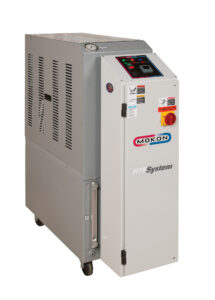Heat transfer systems represent a significant investment in your operation’s capabilities. At Mokon, we understand that proper operation procedures directly impact not only your system’s performance, but also its longevity. Let’s explore two critical phases of operation where following best practices can make a substantial difference in protecting your investment.
Smart Start-Up
Starting your heat transfer system correctly is like warming up before exercise – it prepares the system for optimal performance. When your fluid is cold, its viscosity can be significantly higher than optimal operating conditions, sometimes exceeding 1,000 cSt in cold environments. While your system’s pump can handle this viscosity, rushing to apply full heat can lead to thermal degradation of your fluid.
To protect your system and fluid, we recommend a gradual temperature increase in 10°C – 15°C (20°F – 30°F) increments. This measured approach ensures even heating and prevents localized overheating that could damage your fluid and, consequently, your system’s components.
Careful Shutdown
The shutdown process is equally crucial for system longevity. Remember, your heat source typically runs hotter than your desired output temperature in order to maintain your setpoint. This creates a critical consideration during shutdown: trapped fluid near these hot spots can quickly overheat and degrade if proper cooling procedures aren’t followed.
To prevent this, always allow your system to cool below 66°C (150°F) before turning off the pumps. This simple step prevents fluid from becoming trapped in hot zones where it could thermally degrade, protecting both your fluid and system components from unnecessary wear.
Why Does It Matter?
By following these best practices, you’re not just operating your system – you’re investing in its future. Proper start-up and shutdown procedures help prevent thermal degradation, reduce maintenance needs, and ultimately extend the life of your Mokon system, ensuring it continues to deliver the reliable performance your operation demands.
For specific guidance about your system’s features and capabilities, don’t hesitate to reach out to our technical support team.
